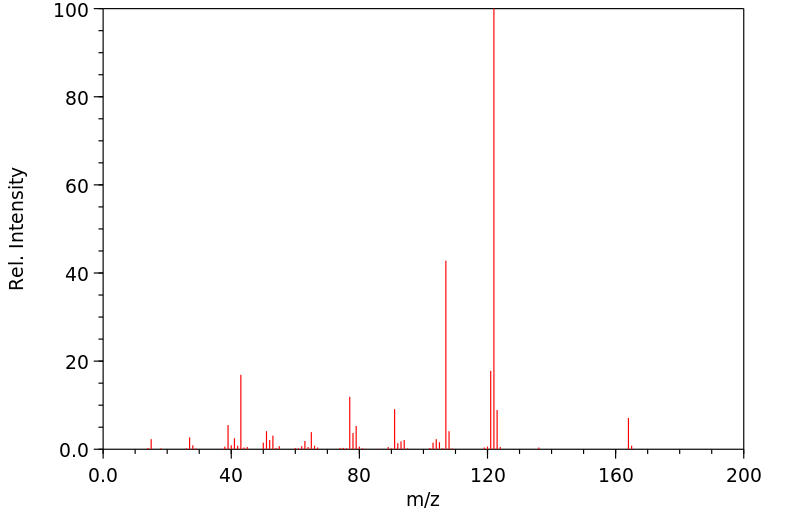(2,4-二甲基苯基)乙酸酯 | 877-53-2
中文名称
(2,4-二甲基苯基)乙酸酯
中文别名
——
英文名称
2,4-dimethylphenyl acetate
英文别名
Phenol, 2,4-dimethyl-, acetate;(2,4-dimethylphenyl) acetate
CAS
877-53-2
化学式
C10H12O2
mdl
MFCD25977406
分子量
164.204
InChiKey
BNXJYMYPBQBNSW-UHFFFAOYSA-N
BEILSTEIN
——
EINECS
——
-
物化性质
-
计算性质
-
ADMET
-
安全信息
-
SDS
-
制备方法与用途
-
上下游信息
-
文献信息
-
表征谱图
-
同类化合物
-
相关功能分类
-
相关结构分类
物化性质
-
沸点:226°C (estimate)
-
密度:1.0298
-
保留指数:1217
计算性质
-
辛醇/水分配系数(LogP):2.4
-
重原子数:12
-
可旋转键数:2
-
环数:1.0
-
sp3杂化的碳原子比例:0.3
-
拓扑面积:26.3
-
氢给体数:0
-
氢受体数:2
SDS
反应信息
-
作为反应物:描述:(2,4-二甲基苯基)乙酸酯 在 1,5,9-三氮杂环十二烷 甲醇 、 四丁基氢氧化铵 、 zinc trifluoromethanesulfonate 作用下, 以 乙腈 为溶剂, 生成 2,4-二甲基苯酚参考文献:名称:金属离子促进了羧酸酯的酯交换反应。结构/活性研究Zn2 +和La3 +催化某些芳基和脂族酯甲醇分解的功效。摘要:研究了甲醇,1,5,9-三氮杂环十二烷:Zn2 +(-OCH3)和La3 +(-OCH3)促进的各种芳基和脂族羧酸酯的甲醇分解,并得出了速率常数(kOCH3,kcat3:Zn(OCH3)和kcatLa(OCH3))以各种方式相关。当存在浓度为5 mmol dm(-3)时,金属离子催化的反应比背景反应快得多,在某些情况下可达到7 x 10(6)倍的加速。两种金属的数据均显示出与离去基团的pKa呈非线性布朗斯台德相关性,并根据随着pKa增加到大于约14.7的值而从金属配位四面体中间体的形成到分解的速率限制步骤的变化进行了分析。 。对数kOCH3反应对vs的曲线图。每个金属离子的log kcat值表示对芳基酯的敏感性较低,而对脂族酯的敏感性较高。提出了观察的机械原理。DOI:10.1039/b414763d
-
作为产物:参考文献:名称:稻壳:引入一种绿色、廉价且可重复使用的催化剂,用于保护醇、酚、胺和硫醇摘要:摘要 以稻壳 (RiH) 为原料,开发了一种温和、高效、环保的方案,用于化学选择性保护苄基和伯和受阻较小的仲脂肪醇和酚作为三甲基甲硅烷基醚以及不同类型的胺作为 N-叔丁基氨基甲酸酯。催化剂。该试剂还能够催化醇、酚、硫醇和胺与乙酸酐的乙酰化反应。该方法的显着特点是后处理简单、反应时间相对较短、收率高、成本低、催化剂的可用性和可重复使用性是该方法的显着特点,可被认为是保护醇、酚的最佳和通用方法之一、硫醇和胺。此外,DOI:10.1016/j.crci.2013.01.018
文献信息
-
Iron-Doped Single-Walled Carbon Nanotubes as New Heterogeneous and Highly Efficient Catalyst for Acylation of Alcohols, Phenols, Carboxylic Acids and Amines under Solvent-Free Conditions作者:Hashem Sharghi、Mahboubeh Jokar、Mohammad Mahdi DoroodmandDOI:10.1002/adsc.201000365日期:2011.2.11single-walled carbon nanotubes (Fe/SWCNTs) represent an efficient and new heterogeneous reusable catalyst for the acylation of a variety of alcohols, phenols, carboxylic acids and amines with acid chlorides or acid anhydrides under solvent-free conditions. The reactions of various primary, secondary, tertiary, and benzylic alcohols, diols, phenols, as well as aromatic and aliphatic amines give acylated
-
Acetylation of alcohols and phenols under solvent-free conditions using iron zirconium phosphate作者:Abdol R. Hajipour、Hirbod Karimi、Amir MastiDOI:10.1016/s1872-2067(14)60280-1日期:2015.4Iron zirconium phosphate (ZPFe) nanoparticles were found to function as an efficient catalyst for the acetylation of a wide range of alcohols and phenols using acetic anhydride, generating good to excellent yields under solvent-free conditions. The steric and electronic properties of various substrates had a significant influence on the reaction conditions required to achieve the acetylation. The catalyst
-
Rice Husk Ash: A New, Cheap, Efficient, and Reusable Reagent for the Protection of Alcohols, Phenols, Amines, and Thiols作者:F. Shirini、Somayeh Akbari-Dadamahaleh、Ali Mohammad-KhahDOI:10.1080/10426507.2013.844142日期:2014.5.4Abstract A mild, efficient, and eco-friendly protocol for the protection of alcohols and phenols as trimethylsilyl ethers has been developed using rice husk ash as a reagent. This reagent is also able to catalyze the acetylation of alcohols, phenols, thiols, and amines with acetic anhydride. All reactions were performed under mild conditions in good to high yields. [Supplementary materials are available
-
Highly efficient and recyclable acetylation of phenols and alcohols by nickel zirconium phosphate under solvent-free conditions作者:Abdol Reza Hajipour、Hirbod Karimi、Afshin KohiDOI:10.1007/s13738-015-0711-z日期:2016.1Nickel zirconium phosphate nanoparticles have been used as an efficient catalyst for the acetylation of a wide range of alcohols and phenols with acetic anhydride in good to excellent yields under solvent‐free conditions. The steric and electronic properties of the different substrates had a significant influence on the reaction conditions required to achieve the acetylation. The catalyst used in the current study was characterized by inductively coupled plasma optical emission spectroscopy, X‐ray diffraction, N2 adsorption–desorption, scanning electron microscopy, and transmission electron microscopy. This nanocatalyst could also be recovered and reused at least six times without any discernible decrease in its catalytic activity.
-
Catalytic Reductive <i>ortho</i>-C–H Silylation of Phenols with Traceless, Versatile Acetal Directing Groups and Synthetic Applications of Dioxasilines作者:Yuanda Hua、Parham Asgari、Thirupataiah Avullala、Junha JeonDOI:10.1021/jacs.6b04018日期:2016.6.29and the use of traceless acetal directing groups, has been employed to provide facile formation of C-Si bonds and concomitant functionalization of a silicon group in a single vessel. Specifically, this approach involves the relay of Ir-catalyzed hydrosilylation of inexpensive and readily available phenyl acetates, exploiting disubstituted silyl synthons to afford silyl acetals and Rh-catalyzed ortho-C-H一种新的、高选择性的键官能化策略,通过两种过渡金属催化剂的中继和无痕缩醛导向基团的使用实现,已被用于在单个容器中轻松形成 C-Si 键并伴随硅基团的官能化. 具体而言,该方法涉及廉价且容易获得的乙酸苯酯的 Ir 催化氢化硅烷化的中继,利用二取代的甲硅烷基合成子提供甲硅烷基缩醛和 Rh 催化的邻-CH 甲硅烷基化以提供二恶唑啉。随后对硅的亲核加成去除了缩醛导向基团并直接提供未掩蔽的苯酚产物,从而在单个容器中获得硅上的有用官能团。这种用于苯酚催化邻 CH 甲硅烷基化的无痕缩醛导向基团策略也成功应用于多取代芳烃的制备。值得注意的是,已经开发了一种新的正式 α-氯乙酰导向基团,它允许空间位阻酚的催化还原 CH 甲硅烷基化。特别是,这种新方法允许获得其他催化途径难以获得的高度通用且分化良好的 1,2,3-三取代芳烃。此外,所得二恶唑啉可以作为色谱稳定的卤代硅烷等价物,不仅可以去除缩醛导向基团,还可以
表征谱图
-
氢谱1HNMR
-
质谱MS
-
碳谱13CNMR
-
红外IR
-
拉曼Raman
-
峰位数据
-
峰位匹配
-
表征信息
同类化合物
马来酰亚胺四聚乙二醇CH2CH2COOPFPESTER
马来酰亚胺六聚乙二醇CH2CH2COOPFPESTER
马来酰亚胺-酰胺-PEG8-四氟苯酚酯
马来酰亚胺-四聚乙二醇-五氟苯酯
马来酰亚胺-三聚乙二醇-五氟苯酚酯
靛酚乙酸酯
阿立哌唑标准品002
间硝基苯基戊酸酯
间氯苯乙酸乙酯
间乙酰苯甲酸
钾4-乙酰氧基苯磺酸酯
酚醛乙酸酯
邻苯二酚二乙酸酯
邻甲苯基环己甲酸酯
邻甲氧基苯乙酸酯
辛酸苯酯
辛酸对甲苯酚酯
辛酸五氯苯基酯
辛酸-(3-氯-苯基酯)
辛酰溴苯腈
苯酰胺,3,4-二(乙酰氧基)-N-[6-氨基-1,2,3,4-四氢-1-(4-甲氧苯基)-3-甲基-2,4-二羰基-5-嘧啶基]-
苯酚-乳酸
苯酚,4-异氰基-,乙酸酯(ester)
苯酚,4-[(四氢-2H-吡喃-2-基)氧代]-,乙酸酯
苯酚,3-(1,1-二甲基乙基)-,乙酸酯
苯酚,2-溴-3-(二溴甲基)-5-甲氧基-,乙酸酯
苯甲醇,4-(乙酰氧基)-3,5-二甲氧基-
苯甲酸,4-(乙酰氧基)-2-氟-
苯氧基氯乙酸苯酯
苯基金刚烷-1-羧酸酯
苯基氰基甲酸酯
苯基庚酸酯
苯基庚-6-炔酸酯
苯基己酸酯
苯基呋喃-2-羧酸酯
苯基吡啶-2-羧酸酯
苯基十一碳-10-烯酸酯
苯基乙醛酸酯
苯基乙酸酯-d5
苯基丙二酸单苯酯
苯基丙-2-炔酸酯
苯基丁-2,3-二烯酸酯
苯基4-乙基环己烷羧酸
苯基3-乙氧基-3-亚氨基丙酸盐
苯基2-(苯磺酰基)乙酸酯
苯基2-(4-甲氧基苯基)乙酸酯
苯基2-(2-甲氧基苯基)乙酸酯
苯基2-(2-甲基苯基)乙酸酯
苯基-乙酸-(2-甲酰基-苯基酯)
苯基-乙酸-(2-环己基-苯基酯)







